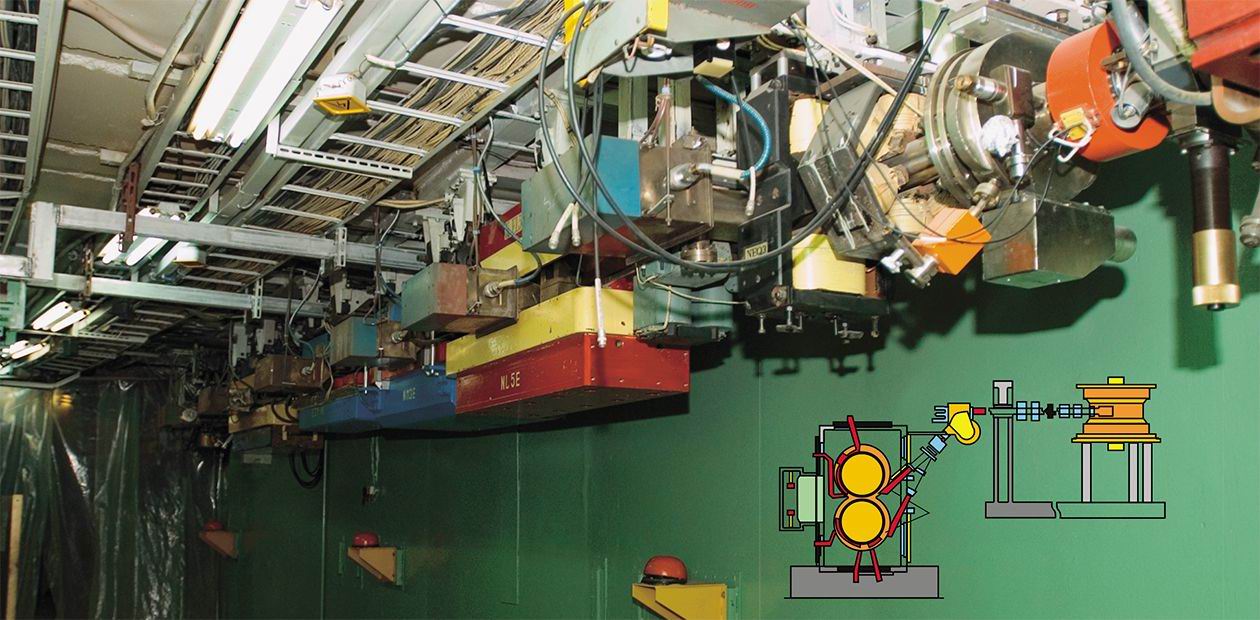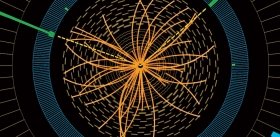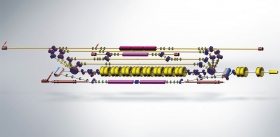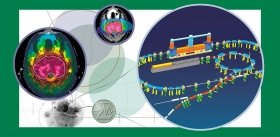Particle Accelerators—Microscopes of Modern Physics
The fact that atom nuclei consist of nucleons, neutrons, and protons, and they, in turn, consist of quarks is one of the most remarkable discoveries of the past century. Together with electrons, quarks form the basis of the Universe, being elementary “bricks” which, in accordance with modern concepts, constitute matter.
It is not easy to investigate elementary particles. They cannot be seen with a microscope and stored for a long time… There is one way out of this situation, which is provided by the fact that high-energy interactions of stable particles result in the generation of new elementary structures whose properties can be investigated. A high level of the kinetic energy of particles is obtained in huge setups, accelerators, where particles are accelerated to a velocity close to the velocity of light.
Lucky meeting
Classical high-energy accelerators where a fast particle beam bombarded a fixed target are large, complex, and expensive. Therefore, nationwide efforts were often needed in the construction of such setups. The problem was solved by the method of so-called colliding beams. Great energy advantages of colliding beams in the creation of new heavy particles were evident. Nevertheless, in the midtwentieth century, the idea of using an extremely rarefied beam of particles instead of a dense target was considered by most physicists to be a good distance in the future.
Many scientists started developing the method of colliding beams. However, considerable advances (experiments with electron-electron scattering) were made in 1965 only by two centers, Stanford University in the United States and the Institute of Nuclear Physics (INP) in Novosibirsk. The latter was founded in 1958 on the basis of a laboratory of the Institute of Atomic Energy headed by G. I. Budker. This marked the emergence of a new direction in the experimental physics of elementary particles.
Academician G. I. BUDKER, outstanding physicist, founder and first director of the Institute of Nuclear Physics of the Siberian Branch of the USSR Academy of Sciences. High-energy physics and the physics of controlled thermonuclear fusion were his main scientific interests
One of the major tendencies in the development of modern physics is the obtaining of higher and higher energies in charged particle accelerators to increase the energy of the interaction reaction of particles. Since the times of Rutherford, the scheme of such experiments has not changed; a fixed target is bombarded by a bunch of fast particles. This scheme, however, is not efficient at high energies when particles are accelerated to near light speeds. At such a speed, the mass of”particles-projectiles” abruptly increases and becomes much greater than the mass of target particles. When a heavy ”projectile” hits a light particle of the target, only an insignificant part of its energy obtained with such difficulty is used by the reaction itself. The “lion’s share”is merely spent for the motion of both particles.
We followed another path, making the target mobile and colliding two particle beams accelerated to the same energy. In this case, the masses of the ”projectile” and target remain equal, and they can turn all their energy into the energy of interaction.
It is very important that at particle velocities close to the light velocity, the effect of interaction of colliding particles increases much more than by a factor of four (in accordance with Newtonian mechanics). For instance, at the collision of two electrons moving towards each other with an energy of a billion of eV, the effect of interaction is the same as that of a conventional accelerator with an energy of 4 000 GeV. The very idea of colliders is not new; it is not a scientific discovery. This is a mere consequence of Einstein’s relativity theory. This idea was expressed earlier but, as a rule, the possibility of its realization was viewed pessimistically. This is understandable. After all, the density of a mobile target, i. e., a beam of particles in conventional accelerators, is by a factor of hundreds of trillions (number with 17 zeros) less than that of a fixed target. The problem of colliding two particles is about as complex as that of ”arranging” a meeting of two arrows, one of which is shot by Robin Hood from the Earth and the other one by Wilhelm Tell from the planet revolving around Sirius. However, the advantages of colliding beams in comparison with conventional methods are great, so that we decided to overcome the difficulties. This required increasing the density of beams to and making them pass many times through each other*.
*Newspaper “Za nauku v Sibiri”, January 14, 1970
The problem of obtaining dense beams of heavy particles with a small angular and energy spread was one of the greatest difficulties on the way of development of accelerating facilities on colliding beams. The idea proposed by G. I. Budker in 1966 was very simple: directing an electron beam parallel to a beam of heavy particles with the same average velocity and low temperature. In this case, the frequency of pair collisions of particles abruptly increases, and heavy particles cool down, transferring a part of their energy to electrons. The electron cooling method first tested at INP in 1974 in experiments with the proton beam is widely used now in many accelerating centers of the world.
The method of colliding beams has become the most efficient method for the study of the microworld structure, while the accelerators based on it provide important information about elementary particles.
Large and small accelerators
VEPP-1, the first facility with colliding beams, was the predecessor of a series of INP accelerators. These accelerators are not the largest in the world. However, the fact that the Institute is capable of producing such equipment allowed it to take part in the creation of in fact large facilities, first-class instruments to study the universe, for foreign scientific organizations. For instance, several hundreds of magnets and superconducting buses were manufactured for the Large Hadron Collider (LHC) being constructed at the border between Switzerland and France at the European Center for Nuclear Research (CERN). For the production of this equipment, the “Golden Hadron” award was conferred to the Institute by its Swiss colleagues.
A. N. SKRINSKY, academician of RAS, G. I. Budker’s disciple who was INP director after him, specialist in accelerator physics and high-energy physics
Now, more than 40 years after the creation of INP in Novosibirsk, it can be said that the underlying scientific and organizational ideas turned out to be rather fruitful.
In particular,
(1) Now, colliding beams first realized at INP are the major source of experimental information in the physics of fundamental properties of matter.
(2) Electron cooling proposed and developed at INP is an important method for increasing the quality and precision of experiments on nuclear physics, elementary-particle physics, and even atomic physics. Such facilities are used in many laboratories of the world, in particular, with the participation of INP.
(3) The method for increasing the accuracy of measuring the masses of elementary particles on the basis of resonant depolarization, which was proposed and developed at INP, made it possible to establish a precision mass scale in the entire range of energies up to 100 GeV.
(4) The method for generating coherent electromagnetic radiation based on accelerators-recuperators created at INP is being developed in many laboratories of the world. It allows obtaining unprecedented average power of such radiation, which yields important results in various fields of science.
(5) The approaches to obtaining X-ray images proposed at INP radically decrease the radiation dose during medical examination and exclude the possibility to carry explosives, plastic weapons, and drugs into airplanes and other places without affecting health.
As for INP achievements in the creation of accelerating facilities, one should mention industrial accelerators, although neither the size nor the particle energy of these modest units are impressing. Since 1963, a series of special electronic accelerators for radiation treatment of materials has been developed here. These opened up new technological capabilities in many national economies, including agriculture and medicine.
A good example is facilities for ion and proton therapy of cancer about which G. I. Budker wrote. Their clinical trials were started about 50 years ago in almost all developed countries of the world, in particular, in Russia. To date, about 50 thousand patients in the world have received ion or proton therapy. The major limitation for a wide use of such methods is the absence of cheap specialized acceleration complexes. In accordance with the estimates of experts, the process of transition from scientific developments to serial facilities for mass therapy of cancer is taking place now.
G. I. BUDKER:
“In the process of work with our major facilities, we created intermediate ones, medium- and low-energy accelerators. <…>
The accelerator beam turned out to be a good worker. Under irradiation, polyethylene, for instance, turns into fine plastic; being cheap and easily producible as before and keeping its wonderful insulating qualities, it becomes resistant to high temperatures.
In the institute, there is a 3-cm-thick steel sheet with a 0.5 meter-long exclamation mark. The mark was burned out by an electron beam directed to the air, and seems to be addressed to metallurgists: “Now you have a new powerful tool for welding, cutting, and fusing!”.
We pay much attention to disinsectization in elevators and granaries. In the world, much grain dies from garner pests. At the same time, one can find grain irradiation doses that are absolutely safe for bread, at which storage pests will stop propagating. <…>
Proton accelerators to an energy of 200 million volt can find wide use. It has been proved theoretically and experimentally that cancer treatment by protons is much more efficient than X-ray and gamma-ray therapy used at present. However, conventional proton accelerators to such energies are very complex, expensive, and cannot be widely used in clinics even of most developed countries. Therefore, the creation of a cheap and easy-to-use proton accelerator is important and worthwhile.
The beam of accelerated particles is miraculous. It can be used to find minerals, sterilize medicaments, conserve products, and disinfect waste waters. It can also be used to transfer energy to long distances, look through concrete and metal, and create new molecules and even atomic nuclei not present in the periodic table. And, finally, with the help of this beam one can create antimatter and new elementary particles. This seems incredible, but this is so. On second thought, there is nothing strange in this. Unprecedented concentration of energy provides a new quality”*.
*Newspaper “Pravda”, February 27, 1969
Such a facility has been developed and is being produced at INP. A distinctive feature of the project of a proton-carbon complex is the use of efficient electron cooling of the ion beam. This method was proposed and used for the first time at INP. Since “cool” ion beams have extremely small transverse sizes and energy spread, the use of this method allows increasing the beam intensity and decreasing the cost and energy consumption of the acceleration complex. This will decrease the cost of the therapeutic course.














